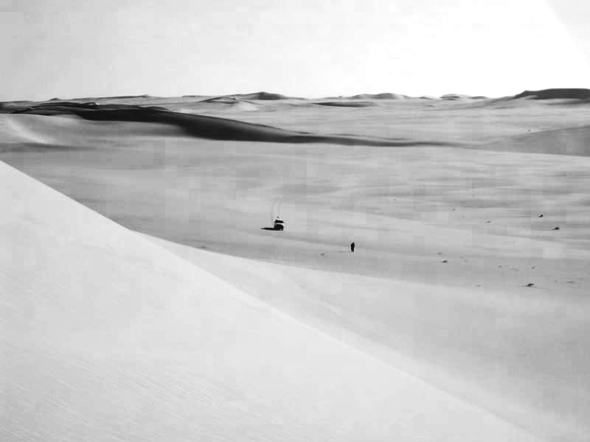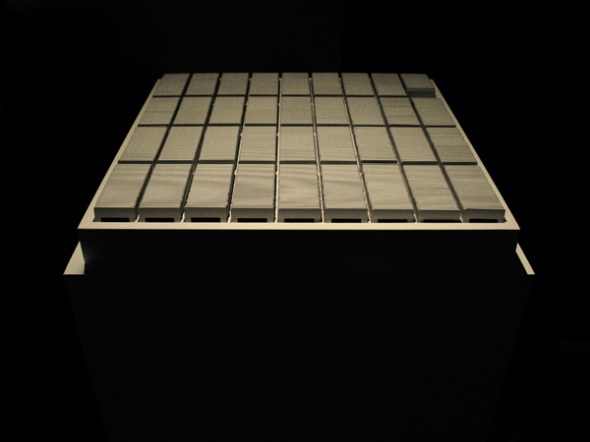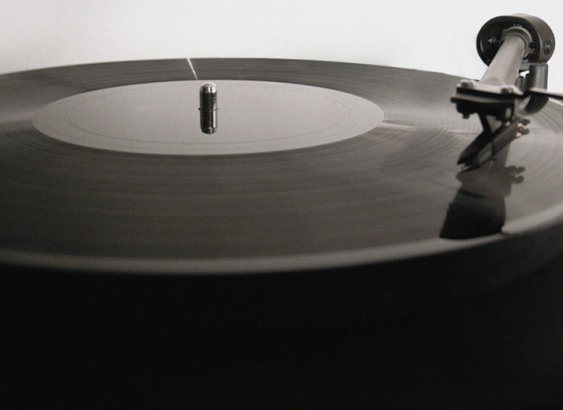A slightly shorter version of this essay on Katie Paterson appeared recently in the Guardian.
Just how small an object, or intervention in the world, can an artist make before the idea of a ‘work’ drifts away on the wind? A couple of years ago a curious postcard landed on my doormat. The photograph was a monochrome view of desert dunes, sharpened into parallel knife edges in the foreground, faded to a stormy void at the horizon. On the reverse, a neatly handwritten legend: ‘Inside this desert lies the tiniest grain of sand.’ I was flummoxed at first as to who could have sent it. Enigmatic junk mailer? Stoned tourist friend? Gnomic stalker? It was a day or two before I mentally trawled the mailing lists I might be on, and twigged it had to be a work by the Scottish artist Katie Paterson.
It turned out that for one of her typically laconic though vastly (in fact cosmically) suggestive projects, Paterson had asked experts in nanotechnology to carve from a grain of sand an almost infinitely smaller fragment – just 0.00005mm across – which object, stuck for safekeeping to a normal-sized grain, she had then deposited somewhere in the Sahara. Another photograph shows the artist silhouetted atop a distant dune, loosing a handful of sand into the wind. With its throwaway invoking of relative dimensions in time and space, Inside this desert… is a neatly ambitious example of the scale and, just as crucial, the tone of Paterson’s work. Hers is an art with a casually humorous take on metaphysical themes and material wonders, based always on sedulous (sometimes gruelling) research and conceived with a serious lightness of touch. Though it’s often dreamed up in lengthy collaboration with scientists around the world, it’s the poetic economy of the work that truly intrigues.
Paterson was born in Glasgow in 1981, studied at Edinburgh College of Art, and spent a year living in Iceland before embarking on a master’s at the Slade. She is not the first artist (Roni Horn springs most easily to mind) to have been inspired by the ancient and active desolation of the Icelandic landscape, but Paterson took from it a set of interests – in darkness, distance, the violent slowness of geology – that already in her early work she suborned to a frankly Romantic and vagrant conceptualism. Her graduation piece at the Slade in 2007 was titled Vatnajökull (the sound of). On the gallery wall was a mobile phone number – 07757001122 – in white neon; if you called the number you were put through to the Icelandic glacier of the title: Paterson had submerged a microphone in its lagoon, so that one could hear the trickle and rush of water, the startling creak of the river of ice as it melts and retreats. Ten thousand people called to listen during the lifetime of the project, while a related work involved recording the glacial soundscape onto two LPs made of refrozen Vatnajökull meltwater: the records were played, and filmed, once before they deliquesced for good.
Since then, Paterson has pursued projects that, although they have seen her engage a variety of scientific specialisms – notably astronomy and astrophysics – and broach subjects at the edges of current scientific knowledge, it would be too easy to corral inside the somewhat sterile rubric of ‘sci-art’: the kind of work that simply translates or (worse) explains discoveries or methods in those fields. The scientists with whom Paterson works – she’s been an artist-in-residence at University College London, and is in regular contact with academic departments, observatories and amateur astronomers around the world – have to accept that the work she ends up making may be quite remote from, at odds with or obliquely related to their own research. So far the relationships have been productive, though one has the sense she must baffle some collaborators with her deadpan redeployment of their work.
Consider her attraction to darkness. In 2009 she worked with scientists at the Mauna Kea Volcano telescope, in Hawaii, to amass images of darkness from the most ancient and distant portions of the universe, and then broadcast one minute of the resulting blackness – a thirteen-billion-year-old void, to be exact – on the New York public-access TV channel MNN. A more expansive, though still pretty austere, instance is Paterson’s ‘lifelong project’ History of Darkness. For some years she has been collecting discrete photographic images of darkness at disparate points in the universe and turning them into 35mm slides (each one numbered, and annotated with distance in light years from earth) and latterly into photographic prints. The slide work is both haunting and comically frustrating: the viewer is invited to pluck slides from a box and hold them to the light: of course, though they depict examples of emptiness from unthinkably distant and ancient points in the universe, they are all exactly the same.
You could read History of Darkness as a slyly literal displacement of the modernist monochrome painting – a reminder that the blank canvases of Kasimir Malevich or Yves Klein were also emanations of those artists’ mystical or cosmically oriented sensibilities. But it hints too at Paterson’s own effort towards a kind of rigorous but wry sublimity, the sort of pleasurable bewilderment and wonder that writers on the sublime attributed to darkness in the eighteenth century. In his Philosophical Enquiry of 1757, Edmund Burke claims that darkness induces a literally painful straining of the eye in its search for light. Immanuel Kant, seven years later in Observations on the Feeling of the Beautiful and Sublime, recounts a dream narrative in which the dreamer is stranded in the ‘boundless void’ of outer space: ‘A fearful kingdom of eternal silence, loneliness and darkness! Unutterable horror overtook me at this sight.’ Paterson’s work seems keenly aware of this tradition of the void, with its Romantic corollary of poetical night thoughts.
Some of those thoughts concern the moon: Edward Young’s mysterious ‘lamp to wisdom’, or as James Atlee calls it in Nocturne, his recent history of moonlight, ‘the Garbo of the skies’. Among Paterson’s early works is Earth-Moon-Earth, for which she translated Beethoven’s Moonlight Sonata into Morse-code radio signals and bounced it off the moon: in the gallery, a player piano recited the sonata as it returned to earth, complete with sudden gaps where the signal had degraded en route. And in 2008 she hired a lighting company to produce a halogen bulb that exactly replicates the qualities of moonlight. The resulting work, Lightbulb to Simulate Moonlight, involves a bare bulb in a darkened gallery, and includes a lifetime’s supply (based on the average human lifespan of sixty-six years) of these beautiful blue orbs: 289 bulbs, each one lasting two thousand hours.
Paterson’s current exhibition at Haunch of Venison gallery in London showcases several works with a similar atmosphere of almost naive wonder, though in some cases the durations and distances are much vaster than in the moon works. Among Kant’s formulations of the sublime is a mathematical variety: sublimity occurs, he says, when our ability to understand the idea of great dimensions or distance, even of the infinite, clashes with our urge to imagine the same. At times, Paterson seems engaged on a domestication of intergalactic sublimity: bringing scientific excursions to the edge of the universe within the purview of earthbound and absurd ritual or performance.
Take 100 Billion Suns, which gives the present show its title. Conceived initially for the 2011 Venice Biennale, the piece is based on images of gamma-ray bursts that Paterson found on the Internet or was sent by her now numerous scientific correspondents. Gamma-ray bursts are the brightest phenomena in the known universe, explosions of intense radiation believed to accompany a supernova when a star dies. (As Paterson’s gallerist Ben Tufnell notes in an accompanying essay, they were first spotted by US military satellites in 1967, while on the lookout for covert Russian nuclear tests.) Paterson took 3216 patches of light from these images and produced sets of colour-matched confetti to be released by small confetti guns at a hundred points around Venice in the opening days of the Biennale. For the London exhibition, where photographs of the Venice detonations are also on show, one of these guns is set off daily in the gallery and the resulting constellation of polychrome dots swept to one side of the room: the most astonishing spectacle from the depths of space reduced to an abject pile of after-party litter.
Elsewhere, distance and duration are invoked with a minimalism whose modesty is as comic as it is cosmic. A record player has apparently stalled while playing the spring movement of Vivaldi’s Four Seasons – in fact it is moving and playing through headphones, but at the same rate that the earth turns: at one revolution per twenty-four hours, the whole record would take four years.
Such works have something in common with Italo Calvino’s Cosmicomics: his 1965 collection of short stories in which scientific fact or conjecture is the occasion for playful allegory bordering on whimsy: life imagined before the condensation of matter, embarrassing revelations signalled across the vasts of time. Paterson’s art often begins, she says, in writing, though these texts are never published or exhibited. Curious minimal narratives do sometimes evolve, however, as in The Dying Star Letters: the artist is on an academic email list that alerts her each time scientists note the death of a star, and she writes a letter of condolence, in this case to a member of the gallery staff. At Haunch of Venison, the letters are arrayed in a long vitrine, and they include several that are black-bordered (unintentional, says Paterson) like memorial cards. One imagines a dark comedy in which Paterson’s correspondent is heartbroken to read: ‘I’m sorry to inform you of the death of the star, SN 2011kd.’
It’s this admixture of the galactic and the mundane that properly characterizes Paterson’s work, and not merely its origins in her scientific collaborators’ enquiries at the further reaches of time and space. The word ‘poetic’ is a treacherous one to apply to any artist; but if one familiar definition of poetry involves the condensation of an artist’s nebulae of research, and star-charts of curiosity, to a still point of metaphoric attraction, then we would have to say that Paterson’s is a poetry of knowledge and mystery, cosmicomically rendered near-at-hand. So near that visitors to her current exhibition, pushing open the gallery door, will hear an odd muted whoosh in place of a door chime – it is the sound of a star dying somewhere far away, and long ago.






Pingback: criticismism » Blog Archive » Found Objects 09/04/12